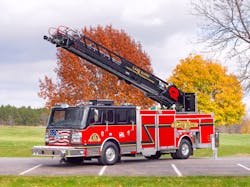Quints, the Swiss Army Knife of Apparatus, Gain Popularity
For a variety of reasons, quint fire apparatus are hot these days with many manufacturers reporting increases in sales across the board.
“Right now, 95 percent of our aerial market is quints,” said Mike Harstad, vice president of sales for Rosenbauer America. “Just about every aerial we build is a quint. We still build good, old-fashioned ladder company aerials, but they are far and few between.”
Harstad attributed the demand for quints to a desire among many municipalities to shrink their staffs by combining engine and ladder companies.
“We’re fighting less fires than before and communities are trying to make the most out of a truck,” Harstad said. “You’ve got to get the most bang out a buck, so they are making their trucks as much as a Swiss Army knife as possible.”
Indeed a quint is a Swiss Army knife when it comes to apparatus. They have pumps, tanks, ground ladders, an aerial device and hose, hence the term quint—five essential items for firefighting.
Firehouse recently spoke with several apparatus manufacturers to learn the latest trends when it comes to one of the most versatile apparatus in any department’s fleet. Weighing in on the topic were representatives of Rosenbauer America, KME Fire Apparatus, Ferrara Fire Apparatus and Spartan Emergency Response.
Scott Weishaar is the executive director of product management for Spartan Emergency Response. Spartan makes a variety of quints and he’s noticed trends in the market.
“Our quint numbers are up,” Weishaar said. He believes the trend is on the rise because the number of suburban communities are increasing.
In those locations, fire departments are looking for something that “gets them in the air” and gives them some access to the roofs of townhomes and single-family dwellings with long setbacks from the main roads.
It’s typical, Weishaar said, to see a fire station with a pumper, a quint, a small rescue and, perhaps an ambulance.
A quint also gives fire departments an elevated master stream for commercial properties and agricultural facilities, he said.
“It’s the demographics that rule the composition of the fleet,” Weishaar said.
A department’s standard operating procedures (SOPs) also dictate what kind of aerial a community puts in service, he said.
“Departments with true ladder companies have no interest in pumps,” Weishaar said. “They want ladders.” He said there’s still 10 to 20 percent of the market that wants straight ladder trucks and Spartan is happy to build those as well.
Building the apparatus that departments want seems to be the name of the game. Harstad said Rosenbauer has built a few tiller quints for departments that want lots of ladders as well as all the amenities of a pumper.
“It presents a few challenges, but we can do it,” Harstad said. He noted the tank and the pump are located on the tractor part of the apparatus, typically where fire departments put air bottle refilling stations.
Harstad offered a theory about why quints are gaining popularity.
“A lot of departments are combining staffs and shrinking the personnel,” Harstad said. “Maintaining a separate ladder company is rare.”
He also said most departments are fighting less fires than ever before and communities are looking to buy versatile apparatus that can do a little of everything.
Harstad acknowledges that despite all the inherent versatility of a quint, they still have drawbacks. There’s only so much space, so what quints carry has to be carefully planned.
“If you want a quint, there are going to be some tradeoffs,” he said noting that there’s not going to be as much space for a full complement of ladders, or five saws for forcible entry work, and the tank might not be as large as desired as the space needs to be dedicated to something else.
“In the past, speccing a quint was all about how much crap can you pile on the truck,” Harstad said. Today, it’s more about shorter rigs with better turning radius and high-tech features to keep firefighters safe, he said.
Peter Hoherchak, the aerial product manager for KME Fire Apparatus, echoed much of Harstad’s comments and said his company too is looking to create quints with tighter turn radius.
“KME has designed another tandem axle model for our 103-foot ladder that is called our ‘Tuff Truck,’” Hoherchak said. “It features a short wheelbase, short overall length, a 96-inch wide body, a reduced overhang and an aerial device that has an outrigger stance of just 12 feet.
He said the new truck has increased compartmentation, a large ladder complement, up to 650 gallons of water all without the need to worry about rear axle capacity.
The new quint configuration should help communities meet the need to reduce staff by basically putting an aerial ladder on a pumper, he said.
Another trend that’s been developing in the quint market is a greater demand for single rear-axle apparatus. Traditionally, quints have tandem rear axles. Some manufacturers have started to offer single rear-axle quints.
Paul Christiansen, vice president of sales and marketing for Ferrara Fire Apparatus, said there are some applications for single-axle aerials with longer aerials, up to 100 feet long and more.
“While there is a place for this type of apparatus in some applications, the buyer has to look at what is being offered in wheelbase and overall length in both a tandem and single axle,” he said, noting the shorter the wheelbase, the tighter the turning radius, regardless of the number of axles.
“With a tandem, rear-axle unit, the fire department has much less concern about how much equipment, hose, and ground ladders can be carried,” Christiansen said. “And, when a truck is delivered and placed into service, the real determinant of whether it’s an effective truck, is; ‘does it carry the equipment needed to make the response in its district?’”
And as the Swiss Army knife of apparatus, that’s exactly what a quint is supposed to do.






